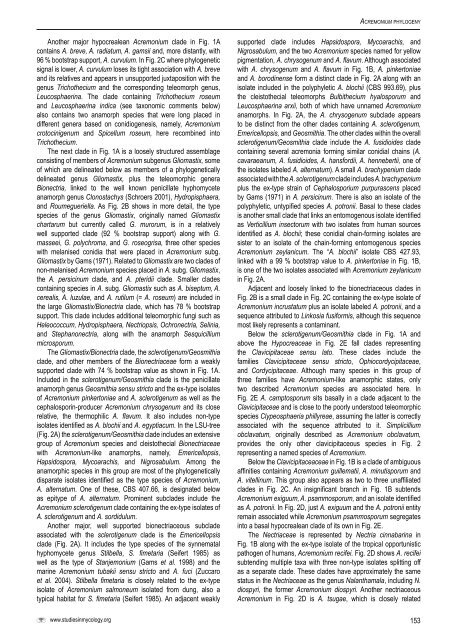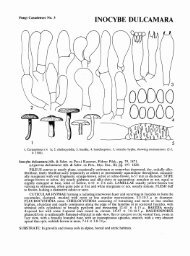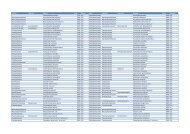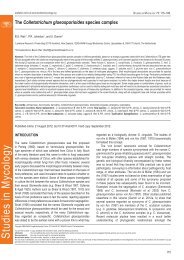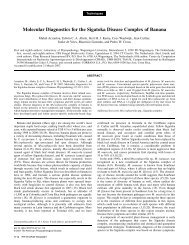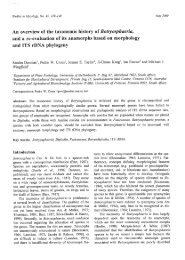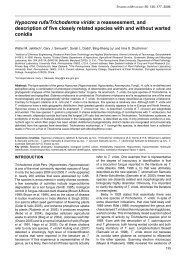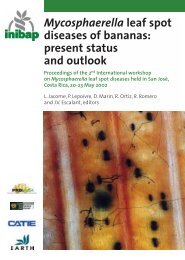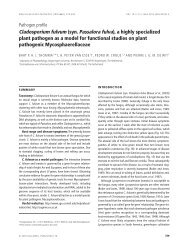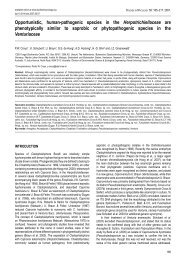Acremonium phylogenetic overview and revision of ... - CBS - KNAW
Acremonium phylogenetic overview and revision of ... - CBS - KNAW
Acremonium phylogenetic overview and revision of ... - CBS - KNAW
Create successful ePaper yourself
Turn your PDF publications into a flip-book with our unique Google optimized e-Paper software.
Another major hypocrealean <strong>Acremonium</strong> clade in Fig. 1A<br />
contains A. breve, A. radiatum, A. gamsii <strong>and</strong>, more distantly, with<br />
96 % bootstrap support, A. curvulum. In Fig. 2C where <strong>phylogenetic</strong><br />
signal is lower, A. curvulum loses its tight association with A. breve<br />
<strong>and</strong> its relatives <strong>and</strong> appears in unsupported juxtaposition with the<br />
genus Trichothecium <strong>and</strong> the corresponding teleomorph genus,<br />
Leucosphaerina. The clade containing Trichothecium roseum<br />
<strong>and</strong> Leucosphaerina indica (see taxonomic comments below)<br />
also contains two anamorph species that were long placed in<br />
different genera based on conidiogenesis, namely, <strong>Acremonium</strong><br />
crotocinigenum <strong>and</strong> Spicellum roseum, here recombined into<br />
Trichothecium.<br />
The next clade in Fig. 1A is a loosely structured assemblage<br />
consisting <strong>of</strong> members <strong>of</strong> <strong>Acremonium</strong> subgenus Gliomastix, some<br />
<strong>of</strong> which are delineated below as members <strong>of</strong> a <strong>phylogenetic</strong>ally<br />
delineated genus Gliomastix, plus the teleomorphic genera<br />
Bionectria, linked to the well known penicillate hyphomycete<br />
anamorph genus Clonostachys (Schroers 2001), Hydropisphaera,<br />
<strong>and</strong> Roumegueriella. As Fig. 2B shows in more detail, the type<br />
species <strong>of</strong> the genus Gliomastix, originally named Gliomastix<br />
chartarum but currently called G. murorum, is in a relatively<br />
well supported clade (92 % bootstrap support) along with G.<br />
masseei, G. polychroma, <strong>and</strong> G. roseogrisa, three other species<br />
with melanised conidia that were placed in <strong>Acremonium</strong> subg.<br />
Gliomastix by Gams (1971). Related to Gliomastix are two clades <strong>of</strong><br />
non-melanised <strong>Acremonium</strong> species placed in A. subg. Gliomastix,<br />
the A. persicinum clade, <strong>and</strong> A. pteridii clade. Smaller clades<br />
containing species in A. subg. Gliomastix such as A. biseptum, A.<br />
cerealis, A. luzulae, <strong>and</strong> A. rutilum (= A. roseum) are included in<br />
the large Gliomastix/Bionectria clade, which has 78 % bootstrap<br />
support. This clade includes additional teleomorphic fungi such as<br />
Heleococcum, Hydropisphaera, Nectriopsis, Ochronectria, Selinia,<br />
<strong>and</strong> Stephanonectria, along with the anamorph Sesquicillium<br />
microsporum.<br />
The Gliomastix/Bionectria clade, the sclerotigenum/Geosmithia<br />
clade, <strong>and</strong> other members <strong>of</strong> the Bionectriaceae form a weakly<br />
supported clade with 74 % bootstrap value as shown in Fig. 1A.<br />
Included in the sclerotigenum/Geosmithia clade is the penicillate<br />
anamorph genus Geosmithia sensu stricto <strong>and</strong> the ex-type isolates<br />
<strong>of</strong> <strong>Acremonium</strong> pinkertoniae <strong>and</strong> A. sclerotigenum as well as the<br />
cephalosporin-producer <strong>Acremonium</strong> chrysogenum <strong>and</strong> its close<br />
relative, the thermophilic A. flavum. It also includes non-type<br />
isolates identified as A. blochii <strong>and</strong> A. egyptiacum. In the LSU-tree<br />
(Fig. 2A) the sclerotigenum/Geosmithia clade includes an extensive<br />
group <strong>of</strong> <strong>Acremonium</strong> species <strong>and</strong> cleistothecial Bionectriaceae<br />
with <strong>Acremonium</strong>-like anamorphs, namely, Emericellopsis,<br />
Hapsidospora, Mycoarachis, <strong>and</strong> Nigrosabulum. Among the<br />
anamorphic species in this group are most <strong>of</strong> the <strong>phylogenetic</strong>ally<br />
disparate isolates identified as the type species <strong>of</strong> <strong>Acremonium</strong>,<br />
A. alternatum. One <strong>of</strong> these, <strong>CBS</strong> 407.66, is designated below<br />
as epitype <strong>of</strong> A. alternatum. Prominent subclades include the<br />
<strong>Acremonium</strong> sclerotigenum clade containing the ex-type isolates <strong>of</strong><br />
A. sclerotigenum <strong>and</strong> A. sordidulum.<br />
Another major, well supported bionectriaceous subclade<br />
associated with the sclerotigenum clade is the Emericellopsis<br />
clade (Fig. 2A). It includes the type species <strong>of</strong> the synnematal<br />
hyphomycete genus Stilbella, S. fimetaria (Seifert 1985) as<br />
well as the type <strong>of</strong> Stanjemonium (Gams et al. 1998) <strong>and</strong> the<br />
marine <strong>Acremonium</strong> tubakii sensu stricto <strong>and</strong> A. fuci (Zuccaro<br />
et al. 2004). Stilbella fimetaria is closely related to the ex-type<br />
isolate <strong>of</strong> <strong>Acremonium</strong> salmoneum isolated from dung, also a<br />
typical habitat for S. fimetaria (Seifert 1985). An adjacent weakly<br />
www.studiesinmycology.org<br />
acremonium phylogeny<br />
supported clade includes Hapsidospora, Mycoarachis, <strong>and</strong><br />
Nigrosabulum, <strong>and</strong> the two <strong>Acremonium</strong> species named for yellow<br />
pigmentation, A. chrysogenum <strong>and</strong> A. flavum. Although associated<br />
with A. chrysogenum <strong>and</strong> A. flavum in Fig. 1B, A. pinkertoniae<br />
<strong>and</strong> A. borodinense form a distinct clade in Fig. 2A along with an<br />
isolate included in the polyphyletic A. blochii (<strong>CBS</strong> 993.69), plus<br />
the cleistothecial teleomorphs Bulbithecium hyalosporum <strong>and</strong><br />
Leucosphaerina arxii, both <strong>of</strong> which have unnamed <strong>Acremonium</strong><br />
anamorphs. In Fig. 2A, the A. chrysogenum subclade appears<br />
to be distinct from the other clades containing A. sclerotigenum,<br />
Emericellopsis, <strong>and</strong> Geosmithia. The other clades within the overall<br />
sclerotigenum/Geosmithia clade include the A. fusidioides clade<br />
containing several acremonia forming similar conidial chains (A.<br />
cavaraeanum, A. fusidioides, A. hansfordii, A. hennebertii, one <strong>of</strong><br />
the isolates labeled A. alternatum). A small A. brachypenium clade<br />
associated with the A. sclerotigenum clade includes A. brachypenium<br />
plus the ex-type strain <strong>of</strong> Cephalosporium purpurascens placed<br />
by Gams (1971) in A. persicinum. There is also an isolate <strong>of</strong> the<br />
polyphyletic, untypified species A. potronii. Basal to these clades<br />
is another small clade that links an entomogenous isolate identified<br />
as Verticillium insectorum with two isolates from human sources<br />
identified as A. blochii; these conidial chain-forming isolates are<br />
sister to an isolate <strong>of</strong> the chain-forming entomogenous species<br />
<strong>Acremonium</strong> zeylanicum. The “A. blochii” isolate <strong>CBS</strong> 427.93,<br />
linked with a 99 % bootstrap value to A. pinkertoniae in Fig. 1B,<br />
is one <strong>of</strong> the two isolates associated with <strong>Acremonium</strong> zeylanicum<br />
in Fig. 2A.<br />
Adjacent <strong>and</strong> loosely linked to the bionectriaceous clades in<br />
Fig. 2B is a small clade in Fig. 2C containing the ex-type isolate <strong>of</strong><br />
<strong>Acremonium</strong> incrustatum plus an isolate labeled A. potronii, <strong>and</strong> a<br />
sequence attributed to Linkosia fusiformis, although this sequence<br />
most likely represents a contaminant.<br />
Below the sclerotigenum/Geosmithia clade in Fig. 1A <strong>and</strong><br />
above the Hypocreaceae in Fig. 2E fall clades representing<br />
the Clavicipitaceae sensu lato. These clades include the<br />
families Clavicipitaceae sensu stricto, Ophiocordycipitaceae,<br />
<strong>and</strong> Cordycipitaceae. Although many species in this group <strong>of</strong><br />
three families have <strong>Acremonium</strong>-like anamorphic states, only<br />
two described <strong>Acremonium</strong> species are associated here. In<br />
Fig. 2E A. camptosporum sits basally in a clade adjacent to the<br />
Clavicipitaceae <strong>and</strong> is close to the poorly understood teleomorphic<br />
species Clypeosphaeria phillyreae, assuming the latter is correctly<br />
associated with the sequence attributed to it. Simplicillium<br />
obclavatum, originally described as <strong>Acremonium</strong> obclavatum,<br />
provides the only other clavicipitaceous species in Fig. 2<br />
representing a named species <strong>of</strong> <strong>Acremonium</strong>.<br />
Below the Clavicipitaceaceae in Fig. 1B is a clade <strong>of</strong> ambiguous<br />
affinities containing <strong>Acremonium</strong> guillematii, A. minutisporum <strong>and</strong><br />
A. vitellinum. This group also appears as two to three unaffiliated<br />
clades in Fig. 2C. An insignificant branch in Fig. 1B subtends<br />
<strong>Acremonium</strong> exiguum, A. psammosporum, <strong>and</strong> an isolate identified<br />
as A. potronii. In Fig. 2D, just A. exiguum <strong>and</strong> the A. potronii entity<br />
remain associated while <strong>Acremonium</strong> psammosporum segregates<br />
into a basal hypocrealean clade <strong>of</strong> its own in Fig. 2E.<br />
The Nectriaceae is represented by Nectria cinnabarina in<br />
Fig. 1B along with the ex-type isolate <strong>of</strong> the tropical opportunistic<br />
pathogen <strong>of</strong> humans, <strong>Acremonium</strong> recifei. Fig. 2D shows A. recifei<br />
subtending multiple taxa with three non-type isolates splitting <strong>of</strong>f<br />
as a separate clade. These clades have approximately the same<br />
status in the Nectriaceae as the genus Nalanthamala, including N.<br />
diospyri, the former <strong>Acremonium</strong> diospyri. Another nectriaceous<br />
<strong>Acremonium</strong> in Fig. 2D is A. tsugae, which is closely related<br />
153


